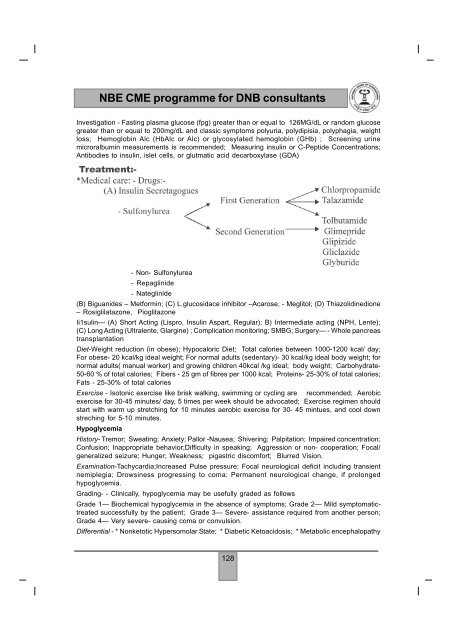<strong>NBE</strong> <strong>CME</strong> <strong>programme</strong> <strong>for</strong> <strong>DNB</strong> <strong>consultants</strong>Investigation - Fasting plasma glucose (fpg) greater than or equal to 126MG/dL or random glucosegreater than or equal to 200mg/dL and classic symptoms polyuria, polydipisia, polyphagia, weightloss; Hemoglobin Alc (HbAlc or Alc) or glycosylated hemoglobin (GHb) ; Screening urinemicroralbumin measurements is recommended; Measuring insulin or C-Peptide Concentrations;Antibodies to insulin, islet cells, or glutmatic acid decarboxylase (GDA)- Non- Sulfonylurea- Repaglinide- Nateglinide(B) Biguanides – Met<strong>for</strong>min; (C) L.glucosidace inhibitor –Acarose, - Meglitol; (D) Thiazolidinedione– Rosiglilatazone, PioglitazoneIi1sulin— (A) Short Acting (Lispro, Insulin Aspart, Regular); B) Intermediate acting (NPH, Lente);(C) Long Acting (Ultralente, Glargine) ; Complication monitoring; SMBG; Surgery— - Whole pancreastransplantationDiet-Weight reduction (in obese); Hypocaloric Diet; Total calories between 1000-1200 kcal/ day;For obese- 20 kcal/kg ideal weight; For normal adults (sedentary)- 30 kcal/kg ideal body weight; <strong>for</strong>normal adults( manual worker) and growing children 40kcal /kg ideal; body weight; Carbohydrate-50-60 % of total calories; Fibers - 25 gm of fibres per 1000 kcal; Proteins- 25-30% of total calories;Fats - 25-30% of total caloriesExercise - Isotonic exercise like brisk walking, swimming or cycling are recommended; Aerobicexercise <strong>for</strong> 30-45 minutes/ day, 5 times per week should be advocated; Exercise regimen shouldstart with warm up stretching <strong>for</strong> 10 minutes aerobic exercise <strong>for</strong> 30- 45 mintues, and cool downstreching <strong>for</strong> 5-10 minutes.HypoglycemiaHistory- Tremor; Sweating; Anxiety; Pallor -Nausea; Shivering; Palpitation; Impaired concentration;Confusion; Inappropriate behavior;Difficulty in speaking; Aggression or non- cooperation; Focal/generalized seizure; Hunger; Weakness; pigastric discom<strong>for</strong>t; Blurred Vision.Examination-Tachycardia;Increased Pulse pressure; Focal neurological deficit including transientnemiplegia; Drowsiness progressing to coma; Permanent neurological change, if prolongedhypoglycemia.Grading- - Clinically, hypoglycemia may be usefully graded as followsGrade 1— Biochemical hypoglycemia in the absence of symptoms; Grade 2— Mild symptomatictreatedsuccessfully by the patient; Grade 3— Severe- assistance required from another person;Grade 4— Very severe- causing coma or convulsion.Differential - * Nonketotic Hypersomolar State; * Diabetic Ketoacidosis; * Metabolic encephalopathy128
<strong>NBE</strong> <strong>CME</strong> <strong>programme</strong> <strong>for</strong> <strong>DNB</strong> <strong>consultants</strong>Invetigation - *Random blood sugar; *ABG; * Chest x raysManagement - In type 1 OMGrade 1-2 Hypoglycemia— 2-4 Dextrose tablets; 2 tsfSugar (10 gm), honey or jam (ideally inwater);A small glass of carbonated sugar- containing soft drink.Grade 3-4 Hypoglycemia— Buccal glucose gel—Proprietary thick glucose gel (e.g. Hypostop) Orhoney, can be smeared on the buccal mucosa (variable efficacy) ; Intravenous glucose— Administer25ml of 50% glucose (or 10Oml <strong>Of</strong> 20%Dextrose) into a large vein, ideally after cannulation;Glucagon- - 1 mg can be given I. V , SIC or I.MIn type 2 DM - Intravenous dextrose — Mandatory continuous infusion of 5% or 10% may be required<strong>for</strong> several days; Diaz oxide; Hydrocortisone; Glucagon; Mannitol — to reduce cerebral odema;Octriotide- - <strong>for</strong> prevention of sulphonylurea - induced hypoglycemia. However, clinical experienceis very limited.Diabetic KetoacidosisHistory – Nausea; Vomiting; Thirst, Polyurea; Abdominal Pain; Shortness of breath; Confusion,Drowsiness, Coma; Acute weight Loss; Generalized muscular weakness; Visual Disturbances;Muscular Cramps.Physical Examination-Tachycardia; Dry Mucous Membranes, Reduced Skin turgor; Dehydration,Hypotension; Tachypnoea, Kussmaul Respiration/Respiratory distress; Abdominal Tenderness;Lethargy, Obtundation, Cerebral Odema, Coma.Differential Diagnosis-Alcoholic Ketoacidosis; Acute Appendicitis; Hyperosmolar HyperglycemicNonketotic coma; Salicylate Toxicity; Hyponatremia; Hypothermia; Lactic Acidosis; MetablicAcidosis.Investigation-Random Blood Sugar; Urine <strong>for</strong> Ketones; ABG; S. Electrolytes (K+, Na+, Mg++, CI-,Bicarbonate, Phosphate) ; Acid-base status-PH, Hco3-, Pco2, â-Hydroxybutyrate; Renal Functiontest; Blood Culture; Chest X-Rays; ECGManagement-Fluids and Electrolytes - Volumes- - lL/h X 3, thereafter adjust according torequirements; Fluids- Normal Saline (150mmol/L) is routine, ypotonic (“Half- normal”) Saline (75mmol/L), if serum Sodium exceeds 150mmol/L, 5% Dextrose 1 L 4-6 hrly when blood glucose hasfallen to15mmol/L; Potassium-No potassium in first 1L unless initial plasma potassium 5.5 mmo1/L,40mmol KCL; severe hypo kalemia may require more aggressive KCL replacement; lnsulin—1. Bycontinuous intravenous infusion- - regular insulin is administrated as I.V(0.1 U/Kg) or 1.M (0.4U/Kg), then0.1 U/Kg/hr continuous I. V infusion; increase 2-10 fold if no response by 2-4hour; Administerintennediate or long acting insulin as soon as patient is eating. Allow <strong>for</strong> over lap in insulin infusionand subcutaneous insulin injection.Other Points - Search <strong>for</strong> and treat precipitating cause (e.g. infection, MI) ; Hypotension usuallyresponds to adequate fluid replacement; CVP monitoring in elderly patients or if cardiac diseasepresent; NG tube, if conscious level impaired to avoid aspiration of gastric content; Urinary Catheter;Continuous ECG monitoring may warn of hyper or hypokalemia; ARDS mechanical ventilation(100% 02; IPPV) avoid fluid overload; Mannitol (up to 1 gm /kg I. V) if cerebral odema suspected;Meticulously updated clinical & biochemical record using a purpose designed flow chart.Hyperosmalar ComaHistory- Elderly with known history of type 2 DM; Polyuria; Weight loss; Diminished oral intake thatculminates in mental confusion, lethargy, and coma; Prior hospitalization <strong>for</strong> hyperglycemia;129
















